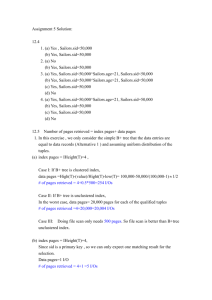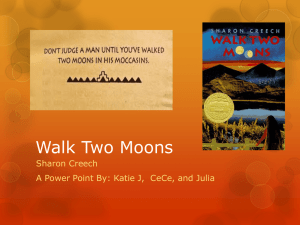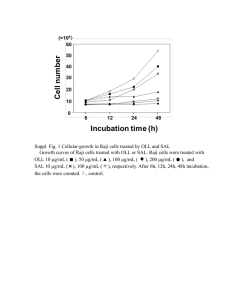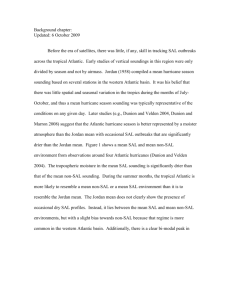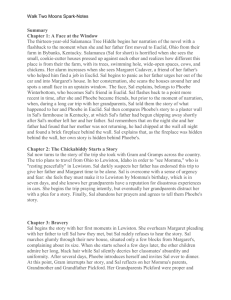Exam1a ( Take_home)
advertisement
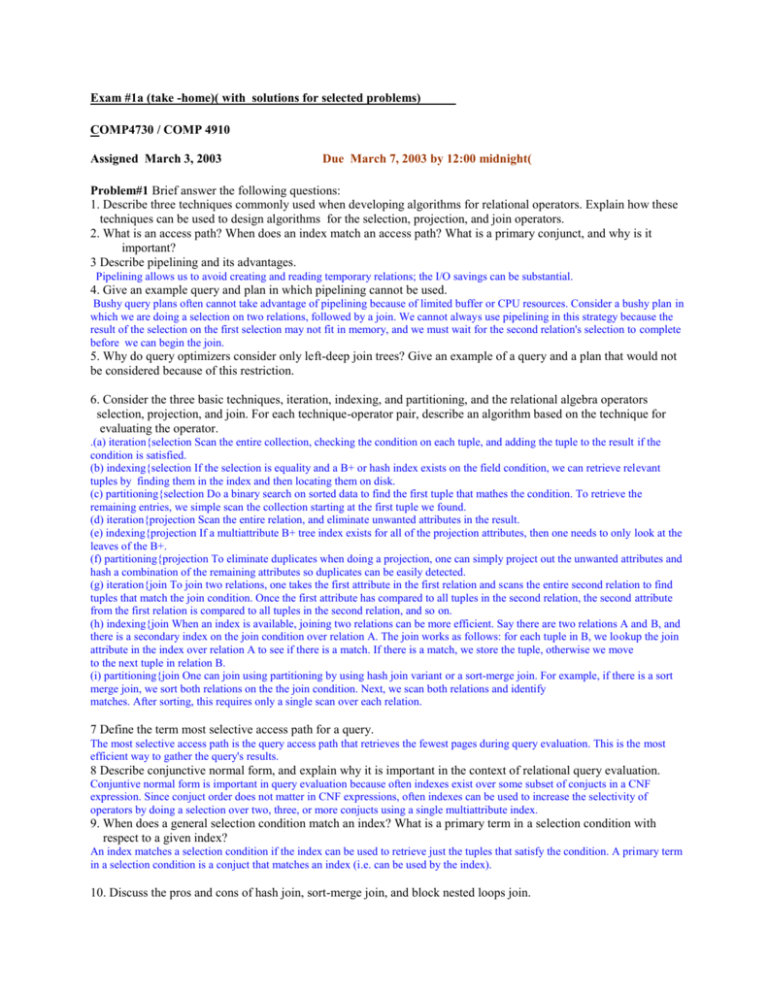
Exam #1a (take -home)( with solutions for selected problems)
COMP4730 / COMP 4910
Assigned March 3, 2003
Due March 7, 2003 by 12:00 midnight(
Problem#1 Brief answer the following questions:
1. Describe three techniques commonly used when developing algorithms for relational operators. Explain how these
techniques can be used to design algorithms for the selection, projection, and join operators.
2. What is an access path? When does an index match an access path? What is a primary conjunct, and why is it
important?
3 Describe pipelining and its advantages.
Pipelining allows us to avoid creating and reading temporary relations; the I/O savings can be substantial.
4. Give an example query and plan in which pipelining cannot be used.
Bushy query plans often cannot take advantage of pipelining because of limited buffer or CPU resources. Consider a bushy plan in
which we are doing a selection on two relations, followed by a join. We cannot always use pipelining in this strategy because the
result of the selection on the first selection may not fit in memory, and we must wait for the second relation's selection to complete
before we can begin the join.
5. Why do query optimizers consider only left-deep join trees? Give an example of a query and a plan that would not
be considered because of this restriction.
6. Consider the three basic techniques, iteration, indexing, and partitioning, and the relational algebra operators
selection, projection, and join. For each technique-operator pair, describe an algorithm based on the technique for
evaluating the operator.
.(a) iteration{selection Scan the entire collection, checking the condition on each tuple, and adding the tuple to the result if the
condition is satisfied.
(b) indexing{selection If the selection is equality and a B+ or hash index exists on the field condition, we can retrieve relevant
tuples by finding them in the index and then locating them on disk.
(c) partitioning{selection Do a binary search on sorted data to find the first tuple that mathes the condition. To retrieve the
remaining entries, we simple scan the collection starting at the first tuple we found.
(d) iteration{projection Scan the entire relation, and eliminate unwanted attributes in the result.
(e) indexing{projection If a multiattribute B+ tree index exists for all of the projection attributes, then one needs to only look at the
leaves of the B+.
(f) partitioning{projection To eliminate duplicates when doing a projection, one can simply project out the unwanted attributes and
hash a combination of the remaining attributes so duplicates can be easily detected.
(g) iteration{join To join two relations, one takes the first attribute in the first relation and scans the entire second relation to find
tuples that match the join condition. Once the first attribute has compared to all tuples in the second relation, the second attribute
from the first relation is compared to all tuples in the second relation, and so on.
(h) indexing{join When an index is available, joining two relations can be more efficient. Say there are two relations A and B, and
there is a secondary index on the join condition over relation A. The join works as follows: for each tuple in B, we lookup the join
attribute in the index over relation A to see if there is a match. If there is a match, we store the tuple, otherwise we move
to the next tuple in relation B.
(i) partitioning{join One can join using partitioning by using hash join variant or a sort-merge join. For example, if there is a sort
merge join, we sort both relations on the the join condition. Next, we scan both relations and identify
matches. After sorting, this requires only a single scan over each relation.
7 Define the term most selective access path for a query.
The most selective access path is the query access path that retrieves the fewest pages during query evaluation. This is the most
efficient way to gather the query's results.
8 Describe conjunctive normal form, and explain why it is important in the context of relational query evaluation.
Conjuntive normal form is important in query evaluation because often indexes exist over some subset of conjucts in a CNF
expression. Since conjuct order does not matter in CNF expressions, often indexes can be used to increase the selectivity of
operators by doing a selection over two, three, or more conjucts using a single multiattribute index.
9. When does a general selection condition match an index? What is a primary term in a selection condition with
respect to a given index?
An index matches a selection condition if the index can be used to retrieve just the tuples that satisfy the condition. A primary term
in a selection condition is a conjuct that matches an index (i.e. can be used by the index).
10. Discuss the pros and cons of hash join, sort-merge join, and block nested loops join.
Hash join provides excellent performance for equality joins, and can be tuned to require very few extra disk accesses beyond a onetime scan (provided enough memory is available). However, hash join is worthless for non-equality joins. Sort-merge joins are
suitable when there is either an equality or non-equality based join condition. Sort-merge also leaves the results sorted which is
often a desired property. Sort-merge join has extra costs when you have to use external sorting (there is not enough memory to do
the sort in-memory). Block nested loops is ecient when one of the relations will t in memory and you are using an MRU
replacement strategy. However, if an index is available, there are better strategies available (but often indexes are not available).
Problem#2 For each of the following SQL queries, for each relation involved, list the attributes that must be
examined to compute the answer. All queries refer to the following relations:
Emp( eid: integer, did: integer, sal: integer, hobby: char(20))
Dept( did: integer, dname: char(20), integer, budget: real)
1. SELECT * FROM Emp E
E.eid, E.did, E.sal, E.hobby
2. SELECT * FROM Emp E, Dept D
E.eid, E.did, E.sal, E.hobby, D.did, D.dname, D. D.budget
3. SELECT * FROM Emp E, Dept D WHERE E.did = D.did
E.eid, E.did, E.sal, E.hobby, D.did, D.dname, D. D.budget
4. SELECT E.eid, D.dname FROM Emp E, Dept D WHERE E.did = D.did
E.eid, D.dname, E.did, D.did
Problem#3 Consider the following schema with the Sailors relation:
Sailors(sid: integer, sname: string, rating: integer, age: real)
For each of the following indexes, list whether the index matches the given selection conditions. If there is a match,
list the primary conjuncts.
1. A B+-tree index on the search key (Sailors.sid ).
σ Sailors:sid=50;000 (Sailors)
2. A hash index on the search key ( Sailors.sid )
σ Sailors:sid<50;000 (Sailors)
3. A B+-tree index on the search key (Sailors.sid, Sailors.age ).
(a) σ Sailors:sid<50;000^Sailors:age=21 (Sailors)
(b) σ Sailors:age=21 (Sailors)
4. A hash-tree index on the search key (Sailors.sid, Sailors.age ).
(a) σ Sailors:sid=50;000^Sailors:age>21 (Sailors)
(b) σ Sailors:sid=50;000 (Sailors)
Problem#4. Suppose you have a file with 20,000 pages and you have 13 buffer pages. Answer the following
questions, assuming that our most general external sorting algorithm is used:
1. How many runs will you produce in the first pass (pass 0)?
In the first pass (Pass 0), ┌ B/N ┐ runs of B pages each are produced, where N is the number of file pages and B is the
number of available buffer pages:
┌ 20000/13 ┐ = 1539 sorted runs.
2. How many passes will it take to sort the file completely?
The number of passes required to sort the file completely, including the initial sorting pass, is┌ log B-1 N1┐ +1 where
N1 = ┌ B/N ┐ is the Number of runs produced by Pass 0:
┌ log 12 1539 ┐ +1 = 3 + 1 = 4 psses.
3. What is the total I/O cost of sorting the file?
Since each page is read and written once per pass, the total number of page I/Os for sorting the file is 2 * N * (#passes):
2*20000*13 = 260000.
4. How many buffer pages do you need to sort the file completely in just two passes?
In Pass 0, ┌ N/B ┐ runs are produced. In Pass 1, we must be able to merge this many runs; i.e., B-1 >= ┌ N/B ┐. This implies that
B must at least be large enough to satisfy B(B - 1)>= N : this can be used to guess at B , and the guess must be validated by
checking the first ineguality. Thus:
With 20000 pages in the file, B = 142 satisfies both inequalities, B = 141 does not, so we need 142 buffer pages.
Problem#5 Consider a disk with an average seek time of 10ms, average rotational delay of 5ms, and a transfer time of
1ms for a 4K page. Assume that the cost of reading/writing a page is the sum of these values (i.e., 16ms) unless a
sequence of pages is read/written. In this case the cost is the average seek time plus the average rotational delay (to
find the first page in the sequence) plus 1ms per page (to transfer data). You are given 320 buffer pages and asked to
sort a file with 10,000,000 pages.
1. Why is it a bad idea to use the 320 pages to support virtual memory, that is, to `new' 10,000,000*4K bytes of
memory, and to use an in-memory sorting algorithm such as Quicksort
2. Assume that you begin by creating sorted runs of 320 pages each in the first pass.
Evaluate the cost of the following approaches for the subsequent merging passes:
In Pass 0, 31250 sorted runs of 320 pages each are created. For each
run, we read and write 320 pages sequentially. The I/O cost per run is 2 * (10 + 5 + 1*320) = 670ms. Thus, the I/O cost for Pass 0 is
31250*670 = 20937500ms. For each of the cases discussed below, this cost must be added to the cost of the subsequent merging
passes to get the total cost. Also, the calculations below are slightly simplified by neglecting the effect of a final read/written block
that is slightly smaller than the earlier blocks.
(a) Do 319-way merges.
1. For 319-way merges, only 2 more passes are needed. The first pass will produce ┌ 31250/319┐ = 98 sorted runs; these can then
be merged in the next pass. Every page is read and written individually, at a cost of 16ms per read or write, in each of these two
passes. The cost of these merging passes is therefore 2*(2*16)*10000000 = 640000000ms.
(The formula can be read as `number of passes times cost of read and write per page times number of pages in file'.)
(b) Create eight `input' buffers of 32 pages each, create an `output' buffer of 64 pages, and do eight-way merges.
With 8-way merges, 5 merging passes are needed. For reading, pages are read in blocks of 32 pages, at a cost per block of
10 + 5 + 1 *32 = 47ms. In each pass, 10000000/32 = 312500 blocks are read. The cost of reading over the 5 merging passes is
therefore 5 *312500 * 47 = 73437500ms. For writing, pages are written in 64 page blocks, and the cost per pass is 12343750ms as
before. The cost of writes over 5 merging passes is 5 * 12343750 = 61718750ms, and the total cost of the merging passes is
73437500 + 61718750 = 135156250ms.
Problem#6. Consider a relation with this schema:
Employees(eid: integer, ename: string, sal: integer, title: string, age: integer)
Suppose that the following indexes, all using Alternative (2) for data entries, exist: a hash index on eid, a B+ tree index
on sal, a hash index on age, and a clustered B+ tree index on hage, sali. Each Employees record is 100 bytes long, and
you can assume that each index data entry is 20 bytes long. The Employees relation contains 10,000 pages. (You may
assume that each page contains 20 tuples)
1. Consider each of the following selection conditions and, assuming that the reduction factor (RF) for each term
that matches an index is 0.1, compute the cost of the most selective access path for retrieving all Employees tuples
that satisfy the
condition:
(a) sal > 100
(b) age = 25
(c) sal > 200 ^ age = 20
(a) sal > 100 For this condition, a file can would probably be best, since a clustered index does not exist on sal. Using the
unclustered index would accrue a cost of 10,000 pages *( 20bytes /100bytes) * 0.1 for the B+ index scan plus
10,000 pages * 20 tuples per page * 0.1 for the lookup = 22000, and would be inferior to the file scan cost of 10000.
(b) age = 25 The clustered B+ tree index would be the best option here, with a cost of 2 (lookup) + 10000 pages * 0.1 (selectivity) +
10,000 * 0.2 ( reduction )* 0.1 = 1202. Although the hash index has a lesser lookup time, the potential number of record lookups
(10000 pages * 0.1 * 20 tuples per page = 20000) renders the clustered index more efficient.
(c) sal > 200 ^ age = 20 The cost for this case using the clustered B+ index on < age; sal > , since only 10 % of all relations fulfill
sal > 200. Assuming a linear distribution of values for sal for age, one can assume a cost of 2 (lookup) + 10000 pages * 0.1
(selectivity for age) * 0.1 (selectivity for sal) + 10,000 * 0.4 * 0.1 * 0.1 = 142.
2. Suppose that for each of the preceding selection conditions, you want to retrieve the average salary of qualifying
tuples. For each selection condition, describe the least expensive evaluation method and state its cost.
. (a) sal > 100 Since the result desired is only the average salary, an index-only scan can be performed using the unclusterd B+ tree
on sal for a cost of 2(lookup) + 10000 * 0.1 * 0.2 ( due to smaller index tuples ) = 202.
(b) age = 25 For this case, the best option is to use the clustered index on < age; sal >, since it will avoid a relational lookup. The
cost of this operation is 2 (B+ tree lookup) + 10000 * 0.1 * 0.4 (due to smaller index tuple sizes)= 402.
(c) sal > 200 ^ age = 20 Similarly to the sal > 200 ^ age = 20 case in the previous problem, this selection should use the clustered
B+ index for an index only scan, costing 2 (B+ lookup) + 10000 * 0.1 (selectivity for age) * 0.1 (selectivity for sal) * 0.4 (smaller
tuple sizes, index-only scan) = 42.
